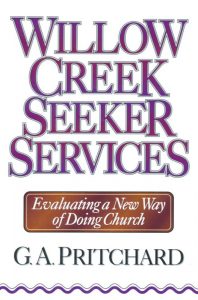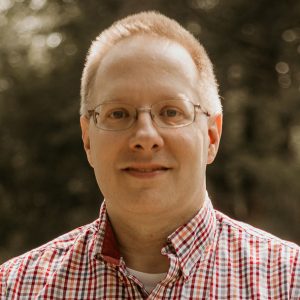Review originally published on JohnRothra.com in August 2008.

Willow Creek Community Church, pastored by Bill Hybels, is known for a type of service referred to as “seeker services.” Is this style of service valid? What lessons can one learn from Willow Creek? G. A. Pritchard spent over two years researching, learning, and investigating this new form of service at Willow Creek, outlining the results of his research in his work Willow Creek Seeker Services.
About the Author
G. A. Pritchard, an evangelical scholar and lecturer, holds a Doctor of Philosophy in Religion in Personality and Society from Northwestern University and a Master of Arts from Trinity Evangelical Divinity School. His background encompasses the disciplines of sociology, theology, and history. Pritchard “has lectured at various conferences, colleges, and universities” and serves as the editor of What in the World Is Real? and Charting a Revolution (9, back cover).
Summary
Pritchard’s work is broken down into two sections. The first thirteen chapters outline the various aspects, background, practices, and philosophies of Willow Creek’s seeker services. In this section, Pritchard provides an objective and fair presentation of what Willow Creek does and why (15-16). The last seven chapters provide the analysis and critique of the seeker services, including sociological and theological analyses.
Willow Creek’s seeker service is based on a seven step process of bringing people into the kingdom and church fellowship. The steps are as follows: (1) church members develop friendships with unchurched individuals, (2) the believer shares the gospel with the unchurched friend, (3) unchurched “Harry”1 visits Willow Creek’s seeker service, (4) “Harry” begins attending believer-focused worship service, (5) “Harry joins a small group,” (6) “Harry uses his gifts in serving,” and (7) “Harry becomes a good steward of his finances” (23-26).
Pritchard concludes that Willow Creek’s desire to construct a worship service that creates a welcome environment for those who are not believers is admirable. Further, he believes that the passion to reach the lost exhibited by the leadership is something many, if not most, churches lack. However, the leadership places so much emphasis on the evangelistic seeker service that regular members are subjected to only the basics of theology because many go to the seeker service rather than the services designed for believers. Also, by focusing on the pleasantness of the facilities and the service tailored for the lost, Willow Creek is vulnerable to incorrect teachings, shallow theology, and even false doctrine. Despite their awareness of such dangers, Pritchard implies that their efforts to avoid the pitfalls may be inadequate (272-87).
Critical Evaluation
There are two ways to critique Pritchard’s work. One would be to evaluate the church services as presented in the first two thirds of the book. This method disregards both the purpose of the book and Pritchard’s own critique of the church services. The other method would be to critique the work in light of its purpose. This method does not evaluate Willow Creek’s seeker service, but critique’s Pritchard’s presentation and critique in light of his purpose. The latter will be the method followed in this review.
Strengths
There are three strengths and two points of interest within the book. The first strength comes from the seven step process of evangelism promoted by Willow Creek leadership, a process that emphasizes personal evangelism (23-24). Once the church member develops a friendship with an unchurched individual, they share the gospel one-on-one with the person, a method that follows the teachings of Christ. Hybel’s church focuses on personal evangelism by the members primarily and evangelism from the pulpit secondarily. This does not mean that evangelistic preaching is not important at Willow Creek, but that the members are encouraged to share the gospel with the unchurched before they come to church and hear the gospel. One must applaud Hybel’s focus on personal evangelism. By including and outlining this process, Pritchard offers his readers a summary of a model evangelistic process.
The second strength is Pritchard’s “fair and accurate” presentation of Willow Creek’s seeker service and underlying philosophy (15-16). Pritchard foresaw that some would remain skeptical regarding his own claims to objectivity and thus he had leadership, both former and current, as well as members review his work in order evaluate its accuracy and fairness. They state that he was fair, objective, and accurate in his presentation of the church. Since those within the church considered his presentation fair, this evaluator is impressed with his foresight and must accept the verdict of the Willow Creek membership.
The final strength is in Pritchard’s evaluation in the last seven chapters. His analysis and critique examine the philosophy underlying the practices, theology, message, and motivations of Willow Creek. Pritchard is thorough and appears fair. The changes he recommends can be summarized as follows: Willow Creek should evaluate the potential consequences of the methods they employ and they must strengthen the theological training of the leadership. Especially refreshing was the final chapter in which Pritchard analyzed the theological implications of Willow Creek’s seeker services. Throughout his evaluation, Pritchard notes that at times the service style and terminology are dictated by the unchurched visitors. This opens the church to the risks of teaching shallow theology and manipulating the audience. However, by implementing the two changes mentioned above, these risks will be minimized if not overcome.
Along with these three strengths, there are two interesting notes worth mentioning. The first is that the leadership of Willow Creek came out of or was influenced by the Jesus Movement of the 1960’s and 1970’s (33). The second is that Hybels was greatly influenced by Gilbert Bilezikian, an Arminian theologian, and Robert Shuller, founder of the Crystal Cathedral in southern California (44-58). The former proclaims a theology that some believe emphasizes man over God, something Calvinists believe is contrary to Scripture; the latter teaches a theology of self-esteem and positive thinking rather than one of sin and salvation, something that many evangelicals denounce as inaccurate. However, Hybels abandoned Shuller’s theology and adopted traditional evangelical theology and a willingness to preach about sin. Nevertheless, the seeker services are still filled with psychological undertones and focus on relevance for today rather than expositional preaching (57-58).
Weaknesses
Only one major weakness stands out in the work due to its structure and Pritchard’s thoroughness. In the opening pages of his evaluation, Pritchard acknowledges that he is in favor of what Hybels and Willow Creek Community Church are trying to do with their seeker services (187-88). He uses the term “critical advocate,” meaning that he advocates their premise, but finds room for improvement. By stating his conclusion before his critique, he risks appearing biased in his evaluation. Although the tone and content do not reveal any such bias, Pritchard should have reserved his conclusions until after his critique, thus, allowing the conclusion to flow from his evaluation rather than appearing to have his evaluation flow from his conclusion.
Conclusion
Willow Creek is one of the most influential churches in recent history in regards to how church is done (11-12). As a result, it is worth the study of evangelism students, pastors, church lay leadership, or anyone interested in learning how to structure a worship service. Pritchard’s work provides an objective, balanced, and thorough presentation and evaluation of Willow Creek’s seeker service. Willow Creek Seeker Services is worthy of inclusion in an evangelism canon and in every believer’s library.
Endnotes
1Lee Strobel discusses in more detail the unchurched individuals that Willow Creek calls “unchurched Harry and Mary,” including who they are, how they think, and how to reach them. His work is based largely on the research done by the founders of Willow Creek. Lee Strobel, et al., Inside the Mind of Unchurched Harry and Mary (Grand Rapids: Zondervan, 1993), 13.
Bibliography
Strobel, Lee. Inside the Mind of Unchurched Harry and Mary. Grand Rapids: Zondervan, 1993.














